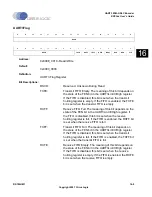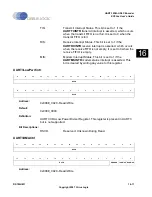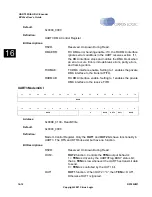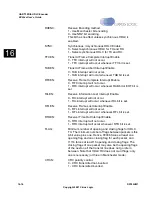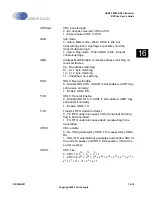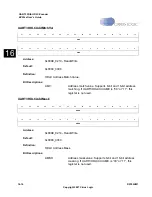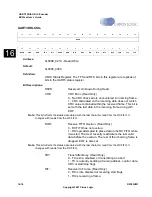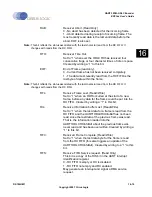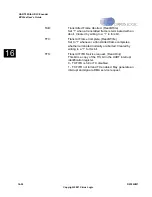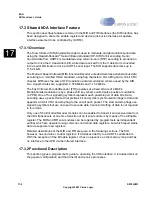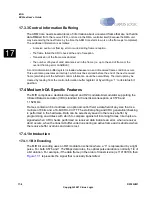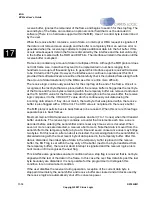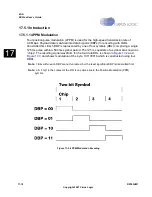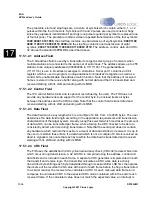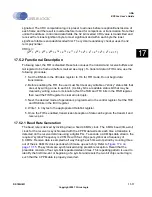
17-2
DS785UM1
Copyright 2007 Cirrus Logic
IrDA
EP93xx User’s Guide
1
7
1
7
17
17.3 Shared IrDA Interface Feature
This section describes features common to the MIR and FIR interfaces (the SIR interface has
been designed to share the enable register and device pins but is otherwise a separate
interface assumed to be controlled by UART2).
17.3.1 Overview
The Slow Infrared (SIR) Encoder/Decoder is used to modulate and demodulate serial data
using the Hewlett-Packard
®
Serial Infrared standard (HP-SIR) for bit encoding. Serial
transmit data from UART2 is modulated using return-to-zero (RTZ) encoding to produce an
output to drive the Ir transmitter LED, while data received from the Ir detector is converted
into a serial bit stream to drive a UART's serial input. The SIR supports data rates up to
115.2 kbit/s.
The Medium Speed Infrared (MIR) Encoder/Decoder encodes/decodes peripheral bus data
according to a modified HDLC standard, using flag characters, bit stuffing and a 16 bit CRC
checker. MIR uses the same RTZ modulation and demodulation scheme used by the SIR.
Two signal bit rates are supported: 0.576 Mbit/s and 1.152 Mbit/s.
The Fast Infrared Encoder/Decoder (FIR) operates at a fixed bit rate of 4 Mbit/s.
Modulation/demodulation is by a phase shift key scheme called pulse position modulation
(4 PPM). One of four signalling symbols represent each possible pair of data bits. Data
encoding uses a packet format that prefixes bit and symbol synchronization flags to data and
appends a 32-bit CRC and stop flag to the end of each packet. The start and stop flags use
signalling symbols that are not used to encode data, hence bit stuffing of data is not required
in this mode.
Only one of the Encoder/Decoder modules can be enabled to transmit and receive data from
the IrDA transducers at one time Selection of an Ir sub-module is by means of the IrEnable
register. The MIR and FIR sub-modules can be regarded by programmers as independent
entities which are operated using common control and data registers, but which report status
data via separate read registers.
Detailed descriptions of the MIR and FIR are given in the following sections. The SIR,
however, has no data or control registers. It interfaces directly to a UART's serial stream.
With the exception of the IrEnable register, it has no presence on the memory map and has
no interface to the APB via the Infrared interface.
17.3.2 Functional Description
This section gives a programmer's guide to operating the IrDA interface. It includes detail on
the general configuration and the transmit and receive processes.
Summary of Contents for EP93 Series
Page 28: ...P 6 DS785UM1 Copyright 2007 Cirrus Logic Preface EP93xx User s Guide PP P ...
Page 162: ...5 36 DS785UM1 Copyright 2007 Cirrus Logic System Controller EP93xx User s Guide 55 5 ...
Page 576: ...15 18 DS785UM1 Copyright 2007 Cirrus Logic UART2 EP93xx User s Guide 1515 15 ...
Page 634: ...17 38 DS785UM1 Copyright 2007 Cirrus Logic IrDA EP93xx User s Guide 1717 17 ...
Page 648: ...19 6 DS785UM1 Copyright 2007 Cirrus Logic Watchdog Timer EP93xx User s Guide 1919 19 ...
Page 688: ...21 32 DS785UM1 Copyright 2007 Cirrus Logic I2S Controller EP93xx User s Guide 2121 21 ...
Page 790: ...27 20 DS785UM1 Copyright 2007 Cirrus Logic IDE Interface EP93xx User s Guide 2727 27 ...
Page 808: ...28 18 DS785UM1 Copyright 2007 Cirrus Logic GPIO Interface EP93xx User s Guide 2828 28 ...


